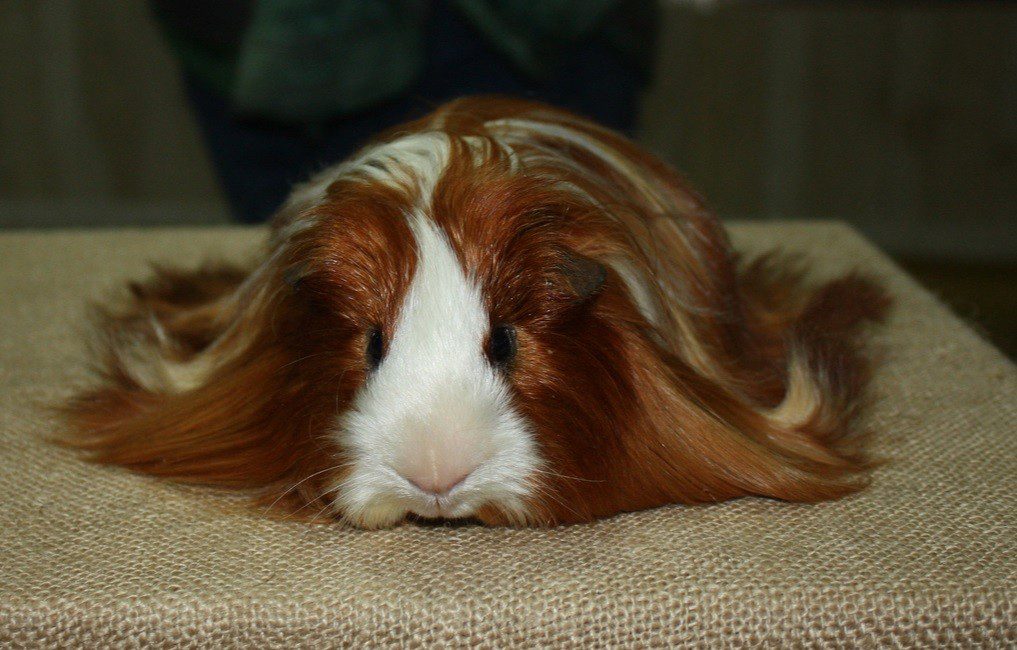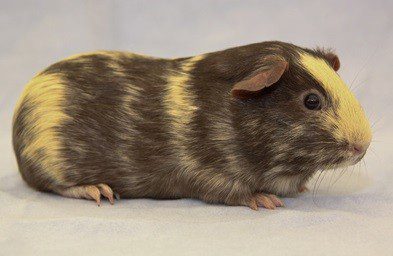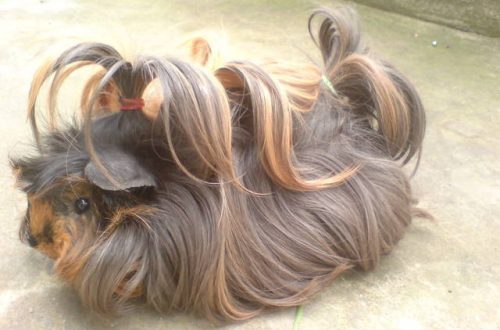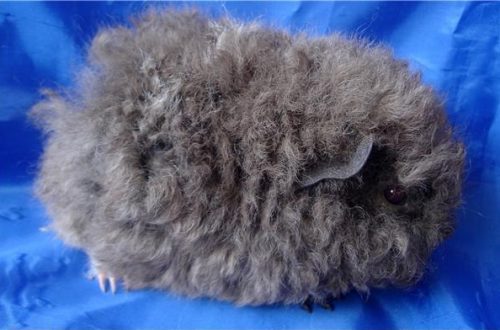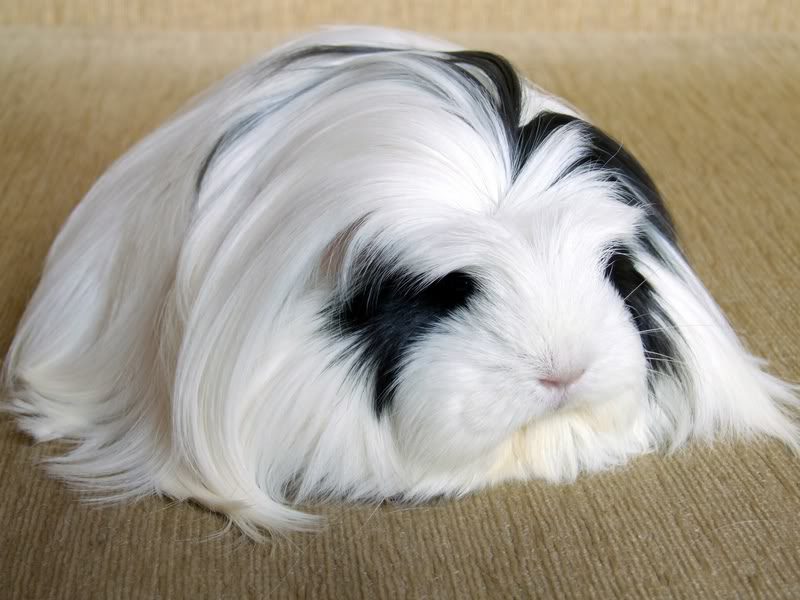
Guinea pig Sheltie
The Sheltie Guinea Pig (Silkie Guinea Pig) is one of the newest breeds of guinea pigs, bred at the end of the XNUMXth century. A funny situation has developed with the name of this guinea pig. In the US, these pigs are called Silkie because of their silky smooth coat. In Europe (and here too) such pigs are called Shelties. Why? They still remain a mystery. The Sheltie is a long-haired breed of guinea pig, and the beautiful, smooth, long coat is the main feature of the Sheltie. Sheltie guinea pigs are often kept as pets, and at the same time they are regular participants in exhibitions and shows. These pigs are very beautiful and elegant, their coat looks like a star’s hairstyle – perfect hair-to-hair styling. Maybe that’s why in the USA they are also called “The Hollywood cavy” – Hollywood guinea pig.
The Sheltie Guinea Pig (Silkie Guinea Pig) is one of the newest breeds of guinea pigs, bred at the end of the XNUMXth century. A funny situation has developed with the name of this guinea pig. In the US, these pigs are called Silkie because of their silky smooth coat. In Europe (and here too) such pigs are called Shelties. Why? They still remain a mystery. The Sheltie is a long-haired breed of guinea pig, and the beautiful, smooth, long coat is the main feature of the Sheltie. Sheltie guinea pigs are often kept as pets, and at the same time they are regular participants in exhibitions and shows. These pigs are very beautiful and elegant, their coat looks like a star’s hairstyle – perfect hair-to-hair styling. Maybe that’s why in the USA they are also called “The Hollywood cavy” – Hollywood guinea pig.

Contents
From the history of Sheltie guinea pigs
Although the Sheltie breed appeared not so long ago (just over forty years ago), today it is one of the oldest recognized breeds. Shelties received official recognition surprisingly quickly, which cannot be said about other breeds of guinea pigs, bred around the same time, but have not received recognition so far. The first Sheltie pig was born in England in 1973 as a result of experimental crossing of black American and Peruvian guinea pigs. Having received such an unusual and attractive guinea pig, the breeders soon put the business on stream, and began to breed new pigs as pets. Today, Shelties are beloved pets in many homes around the world.
Although the Sheltie breed appeared not so long ago (just over forty years ago), today it is one of the oldest recognized breeds. Shelties received official recognition surprisingly quickly, which cannot be said about other breeds of guinea pigs, bred around the same time, but have not received recognition so far. The first Sheltie pig was born in England in 1973 as a result of experimental crossing of black American and Peruvian guinea pigs. Having received such an unusual and attractive guinea pig, the breeders soon put the business on stream, and began to breed new pigs as pets. Today, Shelties are beloved pets in many homes around the world.
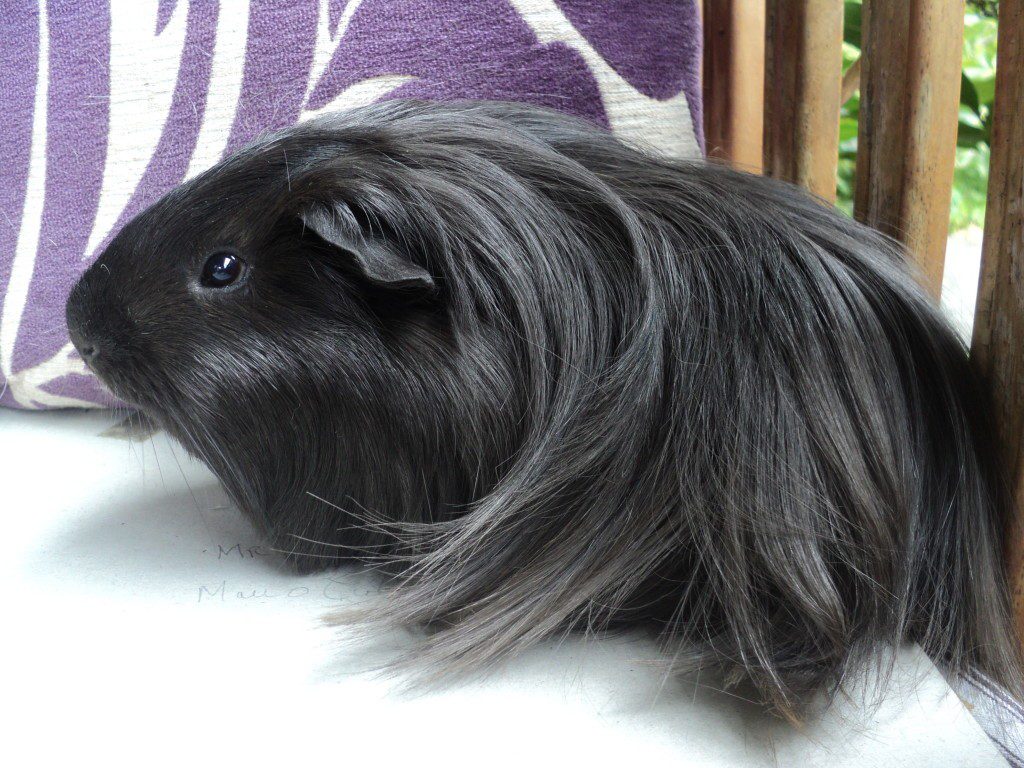
Features of Sheltie Guinea Pigs
As already mentioned, the main feature of the Sheltie is a smooth long fur coat. Their coat is long, silky, absolutely straight. Babies of this breed are born with short hair, which begins to grow at the age of three weeks and then grows without stopping, all their lives. At the age of six months, the Sheltie becomes a magnificent guinea pig with a long and beautiful coat! Since Shelties are descended from Peruvian guinea pigs, the two breeds are often confused. Firstly, the Sheltie does not have a parting along the back, like the Peruvians. In Sheltie, all hair grows in one direction – back, from the head, without partings, rosettes and tufts. In general, the Sheltie guinea pig in its shape resembles a tear, if you look at it from above. Secondly, although both Shelties and Peruvians have long hair, the direction in which it grows on the head is very different. In Peruvian pigs, the hair on the head grows in the form of bangs, falling over the eyes. In Shelties, their smooth hair grows back from the muzzle, like a lion’s mane, which falls on the shoulders and back of the animal. On the sides, the mane may be somewhat shorter than that growing from the middle of the head. Their faces are left open so you can see their adorable little features. Sheltie hair also tends to increase in length in front and behind, with the longest hair being at the back. Satin Shelties (Satin Silkie Guinea Pig) are a variety of shelties that have an unusual satin sheen. Their fur coat is softer and smoother and shimmers very beautifully in the light.
As already mentioned, the main feature of the Sheltie is a smooth long fur coat. Their coat is long, silky, absolutely straight. Babies of this breed are born with short hair, which begins to grow at the age of three weeks and then grows without stopping, all their lives. At the age of six months, the Sheltie becomes a magnificent guinea pig with a long and beautiful coat! Since Shelties are descended from Peruvian guinea pigs, the two breeds are often confused. Firstly, the Sheltie does not have a parting along the back, like the Peruvians. In Sheltie, all hair grows in one direction – back, from the head, without partings, rosettes and tufts. In general, the Sheltie guinea pig in its shape resembles a tear, if you look at it from above. Secondly, although both Shelties and Peruvians have long hair, the direction in which it grows on the head is very different. In Peruvian pigs, the hair on the head grows in the form of bangs, falling over the eyes. In Shelties, their smooth hair grows back from the muzzle, like a lion’s mane, which falls on the shoulders and back of the animal. On the sides, the mane may be somewhat shorter than that growing from the middle of the head. Their faces are left open so you can see their adorable little features. Sheltie hair also tends to increase in length in front and behind, with the longest hair being at the back. Satin Shelties (Satin Silkie Guinea Pig) are a variety of shelties that have an unusual satin sheen. Their fur coat is softer and smoother and shimmers very beautifully in the light.
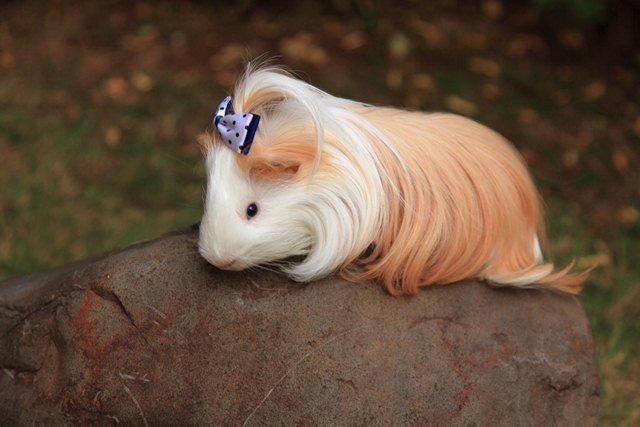
Sheltie: maintenance and care
Thanks to their funny fur coat, shelties make everyone who sees them want to cuddle and touch them. Children especially like these guinea pigs. They are like living soft toys! Despite the docile nature of the Sheltie, this breed of guinea pig is not the most suitable for children and novice breeders, because the Sheltie’s attractive coat requires regular care and attention. If you are not afraid of these worries, then the Sheltie will become an ideal pet and a good friend. How to care for Sheltie coat? Experienced breeders recommend brushing the Sheltie coat at least once a day. Without it, the silky hair ends up tangled and uncomfortable for the guinea pig. Every little Sheltie should be accustomed to the type of comb and combing procedure right from a young age. Then the Sheltie will wait impatiently for you to put her on your lap and begin the procedure. Some of them even squeal in pleasure. Sheltie wool is constantly growing (up to 2,5 cm. per month), so the coat should be trimmed to a comfortable length if your Sheltie is just a pet, or master the skill of winding the wool on special hairpins so that the coat has the proper look and you have the opportunity to show the pig in all its glory at the exhibition. Once every few days, the strands are combed and twisted again. Sheltie Cage A spacious cage, adequate activity throughout the day, and a proper diet are essential ingredients for a healthy and long life for any guinea pig. Since guinea pigs are very active and curious animals, they need more space to live in order to have room to turn around, as they say. The minimum allowable cage area per animal is 0,6 square meters (which corresponds to a 100×60 cm cage). More is even better! But less – no way. But even if the pig has an excellent spacious cage, it still needs to be let out to run. In summer – on the grass on the street, in winter – in the room. From constant sitting in one place, the mumps can become lethargic and painful. Should Shelties be bathed? Bathing guinea pigs is not recommended. The exception is heavy soiling that cannot be removed by other means – wet wipes or a damp cloth. Still, Sheltie breeders bathe their guinea pigs. Especially before shows, to give their coat an extra shine. Ideally, a Sheltie should be accustomed to the procedure of bathing from childhood, so as not to experience the usual severe stress for this situation. If you do decide to give your Sheltie a bath, do it no more than once a month. What to feed Shelties? The diet of this guinea pig is no different from the normal diet of all guinea pigs (link to Feeding article) and should consist mainly of vegetables, fruits, special guinea pig pellets, fresh grass or hay, and clean water. Guinea pigs also need to supplement their daily diet with vitamin C, as this vitamin is not produced in their bodies.
Thanks to their funny fur coat, shelties make everyone who sees them want to cuddle and touch them. Children especially like these guinea pigs. They are like living soft toys! Despite the docile nature of the Sheltie, this breed of guinea pig is not the most suitable for children and novice breeders, because the Sheltie’s attractive coat requires regular care and attention. If you are not afraid of these worries, then the Sheltie will become an ideal pet and a good friend. How to care for Sheltie coat? Experienced breeders recommend brushing the Sheltie coat at least once a day. Without it, the silky hair ends up tangled and uncomfortable for the guinea pig. Every little Sheltie should be accustomed to the type of comb and combing procedure right from a young age. Then the Sheltie will wait impatiently for you to put her on your lap and begin the procedure. Some of them even squeal in pleasure. Sheltie wool is constantly growing (up to 2,5 cm. per month), so the coat should be trimmed to a comfortable length if your Sheltie is just a pet, or master the skill of winding the wool on special hairpins so that the coat has the proper look and you have the opportunity to show the pig in all its glory at the exhibition. Once every few days, the strands are combed and twisted again. Sheltie Cage A spacious cage, adequate activity throughout the day, and a proper diet are essential ingredients for a healthy and long life for any guinea pig. Since guinea pigs are very active and curious animals, they need more space to live in order to have room to turn around, as they say. The minimum allowable cage area per animal is 0,6 square meters (which corresponds to a 100×60 cm cage). More is even better! But less – no way. But even if the pig has an excellent spacious cage, it still needs to be let out to run. In summer – on the grass on the street, in winter – in the room. From constant sitting in one place, the mumps can become lethargic and painful. Should Shelties be bathed? Bathing guinea pigs is not recommended. The exception is heavy soiling that cannot be removed by other means – wet wipes or a damp cloth. Still, Sheltie breeders bathe their guinea pigs. Especially before shows, to give their coat an extra shine. Ideally, a Sheltie should be accustomed to the procedure of bathing from childhood, so as not to experience the usual severe stress for this situation. If you do decide to give your Sheltie a bath, do it no more than once a month. What to feed Shelties? The diet of this guinea pig is no different from the normal diet of all guinea pigs (link to Feeding article) and should consist mainly of vegetables, fruits, special guinea pig pellets, fresh grass or hay, and clean water. Guinea pigs also need to supplement their daily diet with vitamin C, as this vitamin is not produced in their bodies.
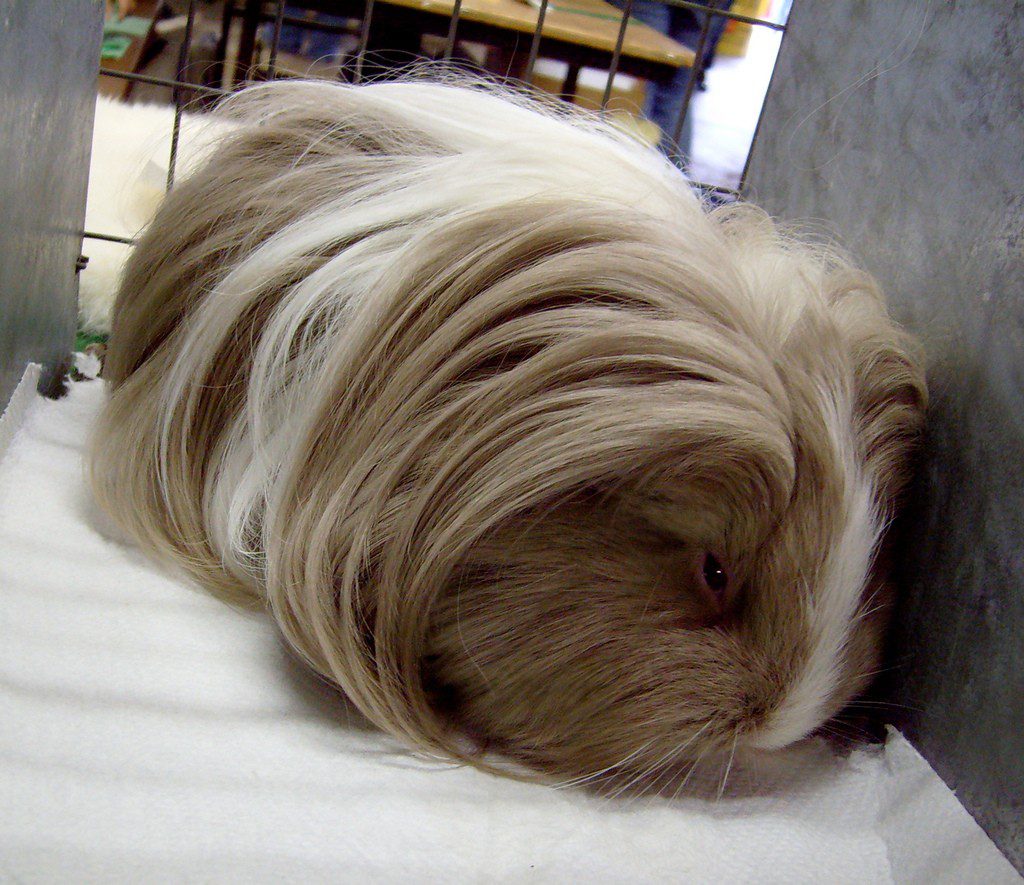
Sheltie character
Among all breeds of guinea pigs, Shelties are known as the most gentle and shy guinea pigs. They take a little longer to get used to new surroundings and new people, so when you bring a new friend into your home, you may have to bribe him with all sorts of goodies to lure him out of the cage and make friends. But then you will have a very affectionate and picky friend!
Among all breeds of guinea pigs, Shelties are known as the most gentle and shy guinea pigs. They take a little longer to get used to new surroundings and new people, so when you bring a new friend into your home, you may have to bribe him with all sorts of goodies to lure him out of the cage and make friends. But then you will have a very affectionate and picky friend!
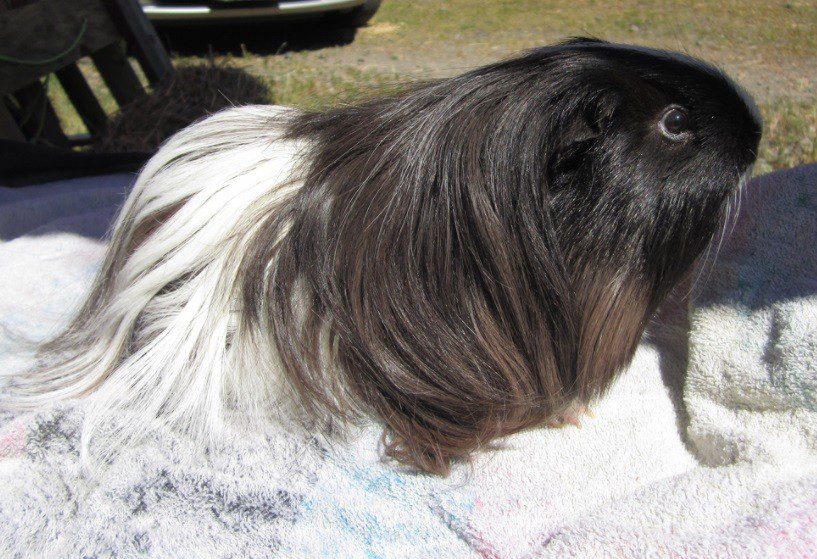
Sheltie colors
Guinea pigs have a great variety of colors. To see this diversity, visit a guinea pig show, but even there you may not see the full beauty of the colors. On one pig there can be several shades at the same time. Sheltie color variations: Golden (pink or dark-eyed) – Golden (pink or dark eyes) Red – Red Lilac – Lilac Beige – Beige Buff (dark cream) – Buffalo (dark cream) Saffron (pale yellow) – Saffron (pale yellow) color) Black – Black White (with pink or dark eyes) – White (with pink or dark eyes) Cream – Cream (cream) Chocolate – Chocolate Slate (blue / gray) – Slate (blue / gray) Agouti Roan
Guinea pigs have a great variety of colors. To see this diversity, visit a guinea pig show, but even there you may not see the full beauty of the colors. On one pig there can be several shades at the same time. Sheltie color variations: Golden (pink or dark-eyed) – Golden (pink or dark eyes) Red – Red Lilac – Lilac Beige – Beige Buff (dark cream) – Buffalo (dark cream) Saffron (pale yellow) – Saffron (pale yellow) color) Black – Black White (with pink or dark eyes) – White (with pink or dark eyes) Cream – Cream (cream) Chocolate – Chocolate Slate (blue / gray) – Slate (blue / gray) Agouti Roan
